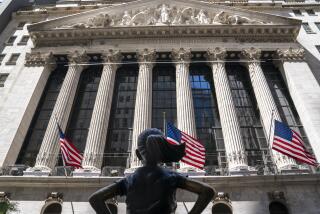Stocks Mostly Higher in Second Most Active Day but Dow Slips 0.60
- Share via
NEW YORK — The stock market finished mostly higher Wednesday after buyers and profit takers slugged it out in the second-busiest session ever at the New York Stock Exchange.
However, the powerful bond market rally faltered as prices pulled back and interest rates edged up.
The Dow Jones average of 30 industrials, up about 18 points at midday, closed with a 0.60 loss at 1,745.45. But most other, broader market measures pushed ahead to new highs.
Volume on the New York Stock Exchange reached 210.25 million shares, up from 187.27 million on Tuesday and the heaviest total since a record 236.57 million changed hands Aug. 3, 1984.
On Tuesday, the Dow Jones industrial average soared 43.10 points in a near-record advance. The buying spree was attributed in large measure to the steep drop in interest rates of late.
Selling Focuses on Blue Chips
Analysts said some stock market participants were also proceeding a little more cautiously. They said the rapid rise in stock prices since last fall had created a strong temptation for investors to take their profits out of the market.
Nevertheless, brokers noted that many people in the financial world believe that the combination of little inflation and interest rates at their lowest levels since the 1970s holds out bright prospects for the economy and corporate profits in the months ahead.
Wednesday’s selling was concentrated in a few blue chips. By contrast, many smaller issues traded in the over-the-counter market and at the American Stock Exchange showed gains just about as dramatic as the ones they recorded on Tuesday.
Among the blue-chip losers were International Business Machines, down 3 at 149, and General Motors, down 1 at 79.
Energy stocks continued to show strength as prices of crude oil futures rebounded from their recent slide. Amoco rose 1 1/2 to 59, Chevron 7/8 to 37 1/2, Atlantic Richfield 2 to 53, Exxon 1 1/8 to 55 5/8 and Phillips Petroleum 3/8 to 10 1/2.
Walt Disney Co. gained 1 3/8 to 34 3/4. The Roy E. Disney family reported that it had recently sold some of its shares but said it had no plans to sell any more.
Most pharmaceutical issues had a good day. Merck climbed 2 3/4 to 155 1/2, Smithkline Beckman 1 to 84 7/8 and Upjohn 1 1/2 to 152.
Broader Indexes Rise
In the bank group, Citicorp rose 1 to 57 1/8, Manufacturers Hanover 1 to 51 1/2 and J. P. Morgan 3/4 to 77 3/4.
The overall tally on the Big Board showed about seven issues rising in price for every four that declined. The exchange’s composite index added 0.59 to 134.17.
Nationwide turnover in NYSE-listed issues, including trades in those stocks on regional exchanges and in the over-the-counter market, totaled 249.24 million shares.
Large blocks of 10,000 or more shares traded on the NYSE totaled 4,076, compared to 3,788 on Tuesday.
Standard & Poor’s index of 400 industrials rose 0.76 to 256.09, and S&P;’s 500-stock composite index was up 0.85 at 232.54.
The NASDAQ composite index for the over-the-counter market gained 2.33 to 369.69. At the American Stock Exchange, the market-value index closed at 267.56, up 3.41.
The Wilshire index of 5,000 equities closed at 2,396.518, up 10.558.
In the bond market, part of the price deterioration was due to investors selling bonds to acquire profits amassed during the market’s recent advances, analysts said.
Signs that the slide in world petroleum prices may have ended hurt the credit markets, analysts said.
Plunging oil prices this year have brightened the inflation picture, a development that has contributed to the bond market’s recent euphoria.
Some traders were discouraged by the level of an interest rate on overnight loans between banks, which might mean that the Federal Reserve Board is maintaining its grip on credit availability, analysts said.
The federal funds rate rose to 7.75% from 7.5625% late Tuesday. This is the interest paid on funds that banks lend each other overnight to satisfy Federal Reserve requirements.
The yield on the Treasury’s benchmark 30-year bond rose to 7.94% from 7.9% late Tuesday. The price of the bond slid about $5 for each $1,000 in face amount. Bond prices and yields move in opposite directions.
Treasury Issues Fall
In the secondary market for Treasury securities, prices of short-term governments fell from 5/32 point to 3/16 point, and intermediate maturities were off point to 5/16 point. The 20-year bond lost 3/4 point and the 30-year issue dropped back 1/2 point, according to the investment firm of Salomon Bros. The movement of a point is equivalent to a change of $10 in the price of a bond with a $1,000 face value.
In the market for corporate securities, industrials and utilities fell 1/2 point in quiet activity.
Among tax-exempt municipal bonds, revenue bonds slid 5/8 point in average trading volume, and general obligations fell 1/2 point in light activity.
Yields on three-month Treasury bills rose four basis points to 6.62%. Six-month bills were also up four basis points to 6.60%, and one-year bills edged up two basis points to 6.61%. A basis point is one-hundredth of a percentage point.
The Merrill Lynch daily Treasury index, which measures price movements on all outstanding Treasury issues with maturities of a year or longer, wound up the trading session at 117.07, virtually unchanged from Tuesday’s close of 117.05. The Shearson Lehman Bros. composite government securities index, which makes a similar measurement, fell 4.10 to 1,223.70.
More to Read
Inside the business of entertainment
The Wide Shot brings you news, analysis and insights on everything from streaming wars to production — and what it all means for the future.
You may occasionally receive promotional content from the Los Angeles Times.










